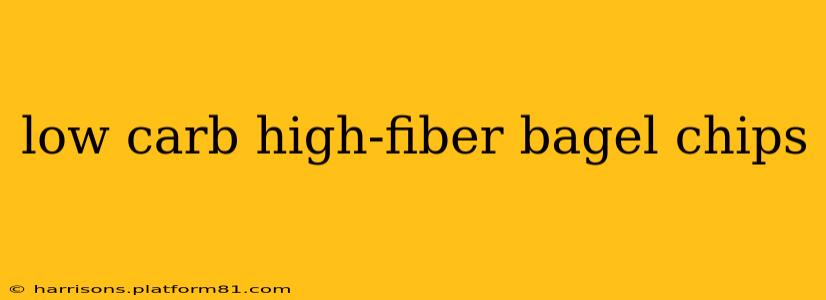Bagel chips offer a satisfying crunch, but traditional versions are often high in carbohydrates. This guide explores how to make delicious low-carb, high-fiber bagel chips, perfect for satisfying cravings without the guilt. We’ll cover everything from the best ingredients to creative flavor combinations, ensuring you discover a new favorite snack.
What Makes a Bagel Chip Low-Carb and High-Fiber?
The key to creating a low-carb, high-fiber bagel chip lies in the ingredients. We need a flour blend that's low in net carbs (total carbs minus fiber) and rich in fiber to provide satiety and digestive benefits. This often involves using almond flour, coconut flour, or a blend of different nut flours, combined with a fiber source like psyllium husk powder or flaxseed meal. These ingredients help to create a chip that's both satisfying and nutritionally beneficial.
Are Low-Carb Bagel Chips Good for Weight Loss?
The effectiveness of low-carb bagel chips for weight loss depends on several factors, including your overall diet and exercise routine. Because they're lower in carbohydrates than traditional bagel chips, they can contribute to weight management by keeping blood sugar levels stable and reducing cravings. However, portion control is essential, as even healthy snacks can contribute to weight gain if consumed in excess. These chips can be a part of a balanced low-carb or ketogenic diet, supporting weight loss goals when combined with a healthy lifestyle.
How Many Carbs are in a Low-Carb Bagel Chip?
The carb count per chip will vary depending on the specific recipe and ingredients used. However, a well-made low-carb bagel chip should significantly reduce the carbohydrate content compared to its traditional counterpart. Aim for recipes that provide detailed nutritional information, including net carbs (total carbs minus fiber), to ensure they fit within your dietary goals. A good target is to keep net carbs per serving as low as possible while maintaining a satisfying texture and flavor.
What are the Best Flour Alternatives for Low-Carb Bagel Chips?
Several excellent flour alternatives can contribute to a low-carb, high-fiber bagel chip. Here are a few popular options:
- Almond Flour: Offers a mild flavor and a slightly nutty taste.
- Coconut Flour: Highly absorbent, so use it sparingly. It adds a subtle coconut flavor.
- Sunflower Seed Flour: Provides a slightly earthy flavor and is a good source of healthy fats.
- Flaxseed Meal: Adds fiber and omega-3 fatty acids, contributing to the high-fiber content.
- Psyllium Husk Powder: Excellent for binding and adding significant fiber.
What are Some Creative Flavor Combinations for Low-Carb Bagel Chips?
The beauty of homemade bagel chips is the endless flavor possibilities! Experiment with different seasonings and herbs to create your perfect chip. Here are a few ideas:
- Everything Bagel Seasoning: A classic combination that always pleases.
- Garlic Parmesan: A savory and irresistible flavor profile.
- Spicy Chili Lime: Adds a kick of heat and zest.
- Rosemary and Sea Salt: An elegant and herbaceous option.
- Cinnamon Sugar (with sugar substitute): A sweet treat option for those who like a bit of sweetness.
Can I Make Gluten-Free Low-Carb Bagel Chips?
Yes, absolutely! Many of the flour alternatives listed above are naturally gluten-free. Ensure that you use certified gluten-free flours if you have a gluten intolerance or celiac disease. Check the labels of all your ingredients to guarantee they meet your dietary needs.
How to Store Homemade Low-Carb Bagel Chips?
To maintain freshness and crispness, store your homemade low-carb bagel chips in an airtight container at room temperature. They should stay crisp for several days. For longer storage, consider freezing them in an airtight container or freezer bag. Freezing helps maintain their texture and flavor for extended periods.
Conclusion: Enjoy the Crunch Guilt-Free!
Making low-carb, high-fiber bagel chips allows you to enjoy a crunchy, satisfying snack without the high carbohydrate load of traditional versions. By experimenting with different flour blends, flavor combinations, and baking techniques, you can create a healthy and delicious treat that fits perfectly into a balanced diet. Remember to always check nutritional information to ensure your recipe aligns with your dietary needs. Happy snacking!
